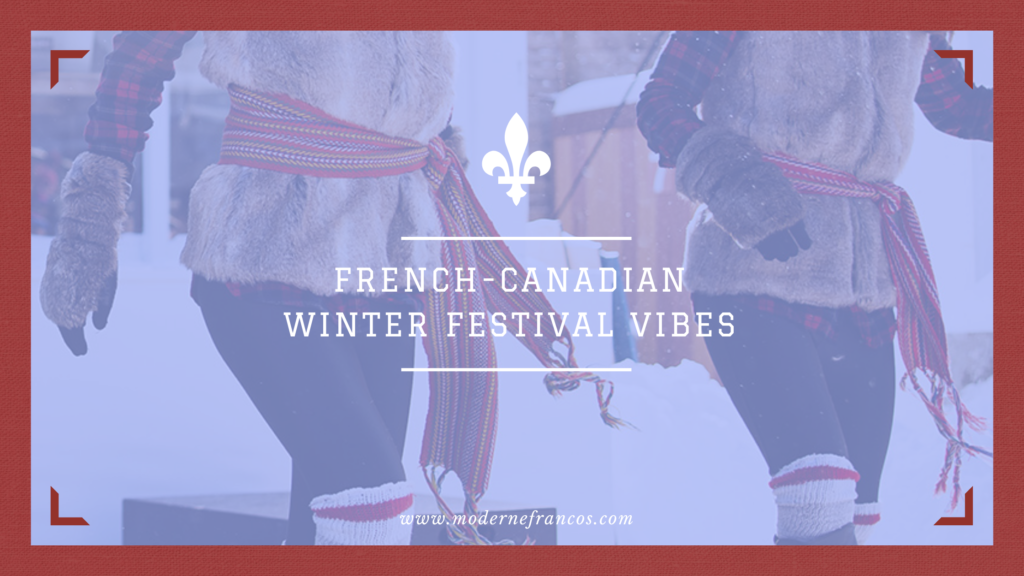
Every winter, several New France-inspired festivals in Canada bring in the crowds with their ice sculptures, parades, skating, and more. However, some activities won’t be taking place this coming year, but there’s a hidden aspect in plain sight that doesn’t get the recognition it deserves: les costumes!
If you’re thinking that most people attend these winter festivals wearing anything that will keep them warm, this is true on most counts. But there’s an intentional style about the textiles, textures, colors, and shapes of the winter clothing worn by performers, dancers, and attendees.
As I’ve covered in my previous piece about suggested traditional and cultural dress for Franco-Americans to join in on the festival fun, this is the more winter-focused compliment to that post. If you’re looking for the history of the capote and ceinture fléchée, these pieces were better explained in the mentioned post.
In understanding the traditional clothing and costumes of cultures and why I firmly believe they’re essential to acknowledge, it’s the fascination with how different cultures express how they see themselves in a visually artistic form.
Now, when it comes to the freezing temperatures, it may seem like there’s no “style” to the layers of thick clothing put on for purely functional reasons. But, although it’s vital to put function over style, especially in the winter, there is a definite pattern of certain styles shown in these cultural costumes at French-Canadian winter festivals. Particularly, festivals that acknowledge the winter clothing of the fur trappers and travelers of the past referred to as les voyageurs.
At cultural events, it’s fun to immerse yourself in the particular time period presented or wear similar clothing to what your ancestors wore before modernization took over our clothing choices. Imagine a time when you had to make your own clothes by hand. We can put ourselves in another character for a day depending on what we wear, especially at these festivals inspired by les voyageurs of French Canada. So, throughout this post, I’ll refer to the collective of these outfits as cultural costumes and the festivals will be labeled under the collective of Winter Festivals.
So let’s look at the costumes worn and pick up some tips for our own winter wardrobe to feel like a voyageur all season.
Les Couleurs
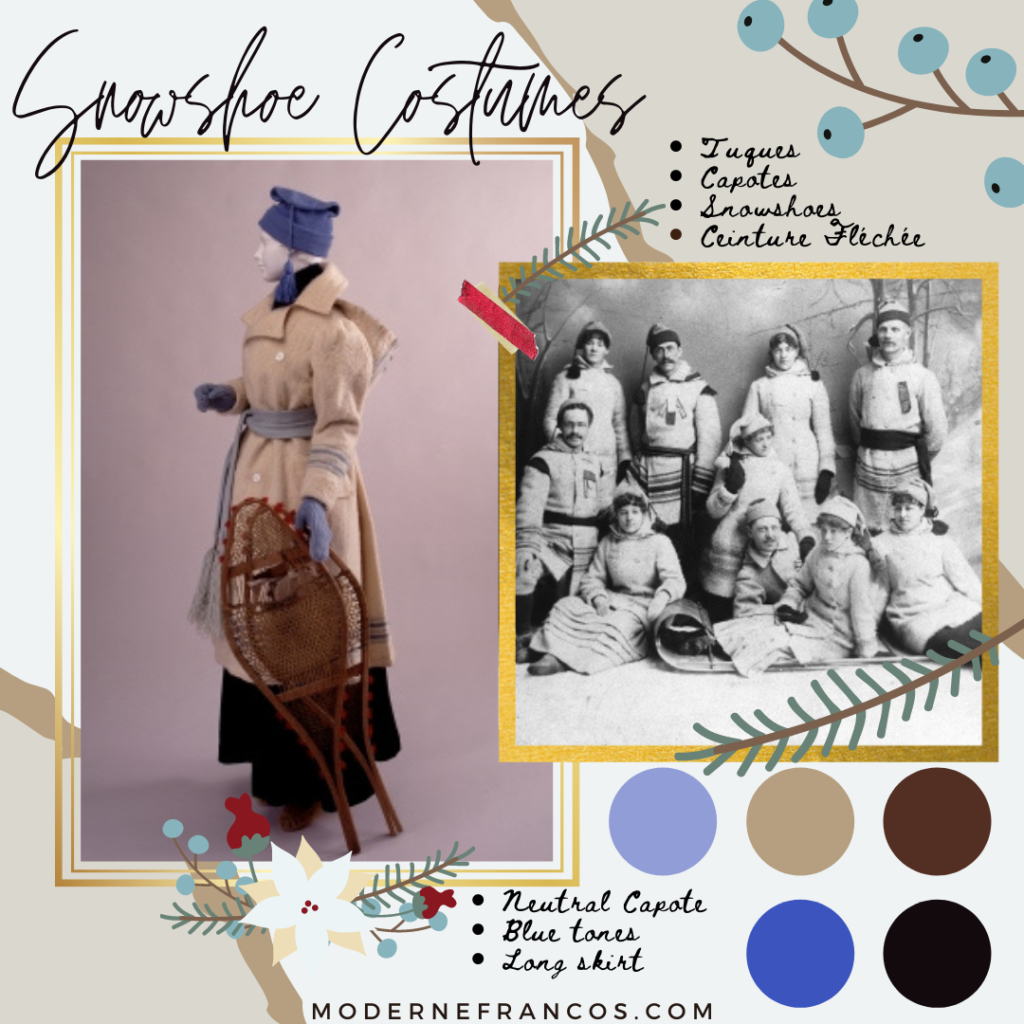
In looking over the winter costumes inspired by les voyageurs, solid colors are used minimally but create a bold pop of color that is appealing to the eye. When you pair a neutral color, like the tan, brown, and gray shades above, it creates a sharp contrast that compliments the outfit.
Will any bright or bold solid color work well with your neutral capote? Sure, but it’s best to look to nature for color inspiration because it’s our best color-matching artist. When our eyes see colors in nature during all four seasons, they see how colors naturally create cohesiveness, which then pleases our eyes.
Think about all of the colors you see during wintertime: red and green from cardinals sitting on the branches of evergreen trees, all sorts of blues from the sky and frozen lakes, and muted pinks and purples from the lights in the midnight sky.
Then, think about how these colors look against the neutral colors of the white snow and ice, the browns and tans of the tree trunks evergreens, and the icy grays from dangling icicles.
Solid colors that look particularly stunning in winter are icy blues and pinks, deep reds and blues, rich greens, as well as burgundy and maroon. These bold colors help us see the beauty in winter when the temperatures drop to freezing levels and the snowstorms roll in.
Another tip is to follow the three-color formula, which some of these festival costumes follow. The combination starts with a neutral, which doesn’t count as a color in this guideline. So besides black, white, tan, or gray, you have free rein to choose three matching colors to make any outfit look complete. Again, it’s not a rule for every outfit but a fun way to add more interest with the cohesiveness of the three colors.
Many voyageur costumes rely on at least one bold color to stand out from all of the neutral colors of their capotes. So you can figure out which winter colors you want to emphasize, whether it’s the three-color formula, or you decide to use one or two bold colors instead.
Textiles et Motifs
Getting into textiles, these voyageurs below utilize heavier fabrics like thick knitted tuques and capotes made of wool to stay warm in their costumes. Other materials made to make these costumes are cotton, flannel, and fleece. But what’s with them wearing several different patterns together?
We’re always advised to avoid mixing patterns, but there’s a way to successfully pull it off. Like the three-color formula above, pick a color from the pattern of a piece of clothing you want to wear. Then, find another pattern with the same color to make a match.
Although this could work perfectly fine, take it up a notch and make sure one of the patterns is smaller than the other. When you pair two patterns of the same size, they can look too busy. The key is color matching at least one color from each pattern and making sure one pattern is more subtle so the whole ensemble can blend together. This technique also looks more intentional than throwing on random patterns.
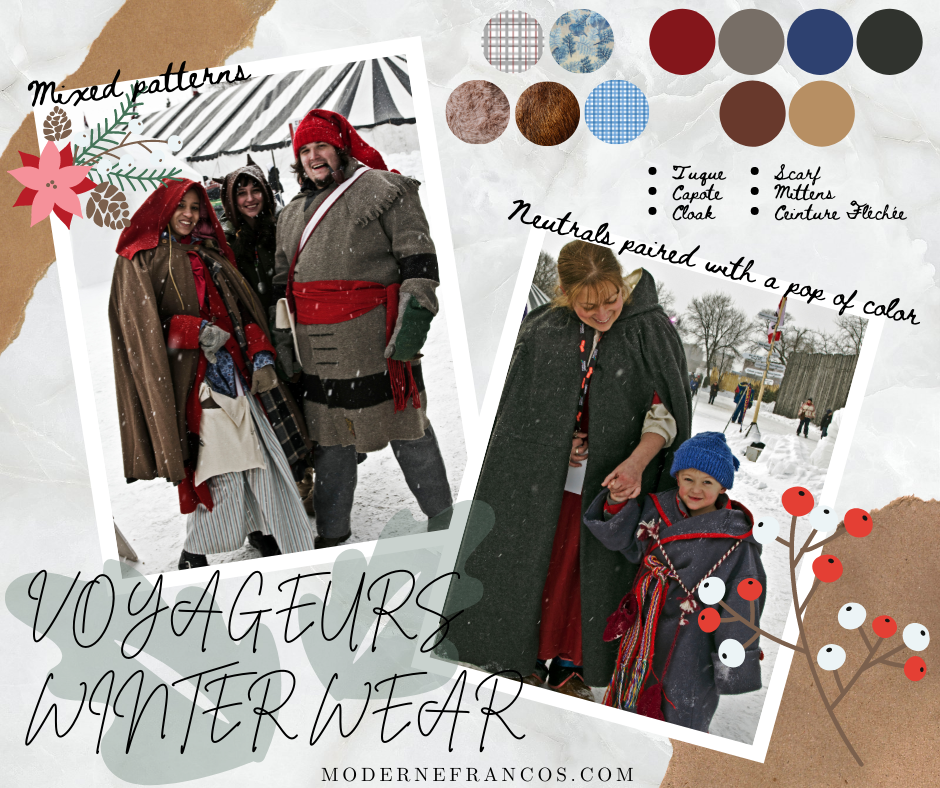
Notice how les voyageurs in the photo on the left pair different patterns while highlighting their red pieces. The woman in the red and tan cloak is effortlessly pairing her red clothing with three neutrals: tan clothing pieces and her creme tote with black boots.
Then, she has three different patterns: blue floral, light blue with dark stripes, and black and tan plaid. Notice how the blue pieces are two different shades (although the same blue would have worked, as well), but the floral print is small and delicate. The plaid inside her cloak is of neutral colors and the pattern is larger than the blue patterns, creating an interesting mix rather than something visually busy. Of course, red and blue are beautiful to pair, so her costume also offers an additional touch of bold colors.
The voyageur man in the photo on the right has a more simplified costume, but it’s a great way to play up the red pieces he’s wearing. He’s pairing a neutral-colored capote with two other neutral colors: gray pants and his mittens topped with olive, which can work as a neutral-like color. The satchel strap around his shoulders is creme with a sliver of red showing from underneath. Because his costume is made of primarily neutrals, the red tuque and ceinture fléchée are emphasized.
Compared to the little boy in the photo on the right, he has a gray wool capote with red trim detail that matches the red in his ceinture fléchée. But the mittens tied around his belt are burgundy, a neutral-like color that pairs beautifully with gray and creates an interesting dynamic when paired with red. However, burgundy and cool-toned reds are a better combination for a more cohesive match.
Rather than accentuating the bright red tones in the costume, his tuque is a bold blue that pairs well with the burgundy mittens. So, even though his outfit has a mix of warm and cool tones, the blue tuque balances out the conflicting red tones that don’t quite match. Preferably, I would suggest choosing colors of similar undertones for each individual outfit, but styling rules can always be slightly broken for a contrasting look.
Layering
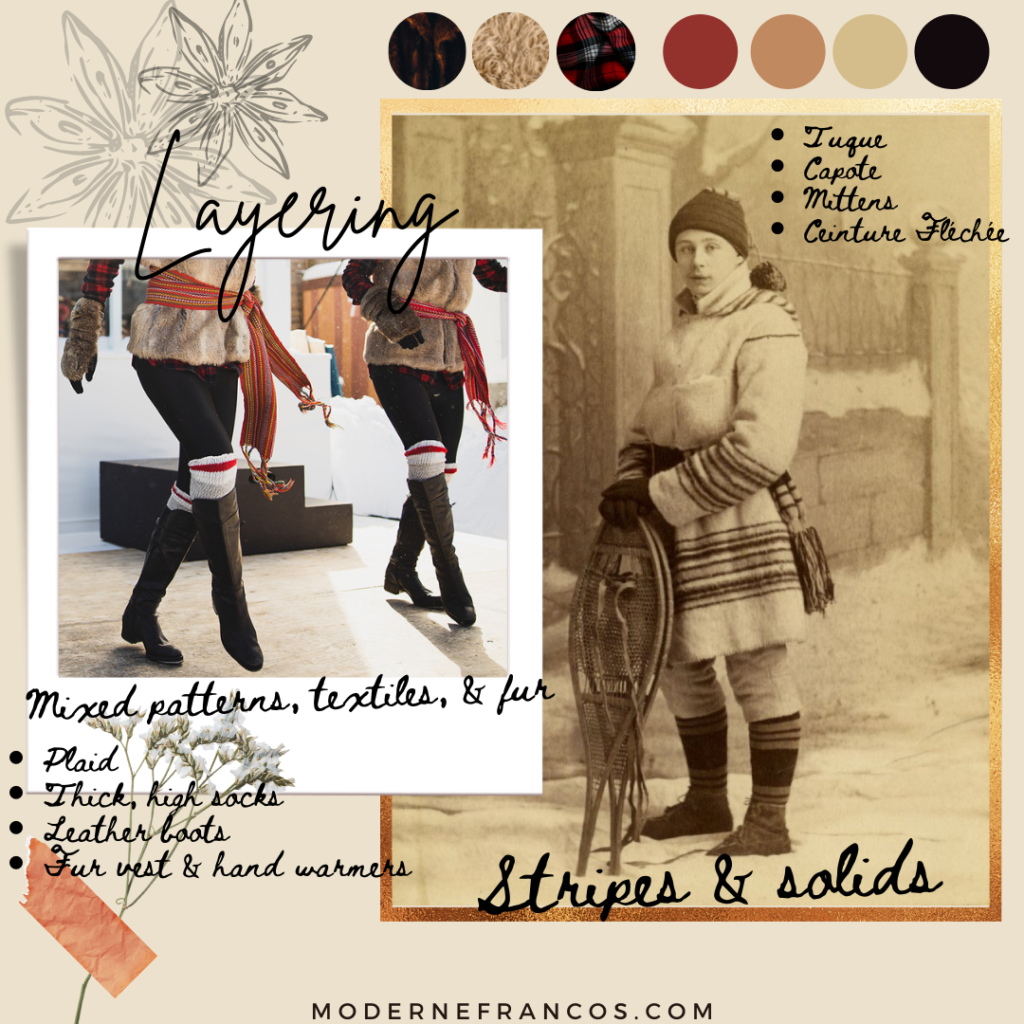
During winter, layering needs to be everyone’s go-to to stay warm, but we often throw on layers without putting much thought into how it looks. This is understandable because it’s much better to dress for functionality than aesthetics. But these two concepts can certainly work together to make a creative and cohesive winter outfit that will show intent rather than throwing on any old sweatshirt.
There’s a collective visual pattern of wearing the ceinture fléchée among men and women with layering. As well as donning plaid and stripes with more textural pieces like fur and leather that will keep us all warm. Even the varieties of faux fur and “pleather” would work if that’s your preference.
Layering in cold temperatures requires a layer of thermal underwear, then the creativity can begin. For the dancers at Le Carnaval de Québec in the photo above, they’ve layered a long-sleeved plaid shirt with a fur vest on top for extra warmth.
The black leggings are most likely lined with fleece, which can be worn on their own or with trousers for an extra layer. Their long, knee-length socks are another layer that adds visual interest while breaking up the dark colors between the leggings and black leather boots.
From what we can see in the photo, they finish the look with black gloves covered with fur hand warmers and the ceinture fléchée wrapped around the vest to tie it all together.
Les Costumes Modernes
In the spirit of fun to lift this cold winter season, I dug through my closet to put some outfits together while staying within the costume guidelines highlighted throughout this post.
Now, I would ideally be wearing the longer capote and ceinture fléchée in the Snowshoe Costumes collection to make it more authentic to the theme of these Winter Festivals. But I currently don’t own those items, so these outfits are incomplete in the photos: these are to show what would be worn underneath the addition of a proper capote.
But there are more layers than what it seems in these photos! I’ll go through my decision behind each of them, from the colors to patterns to the style.
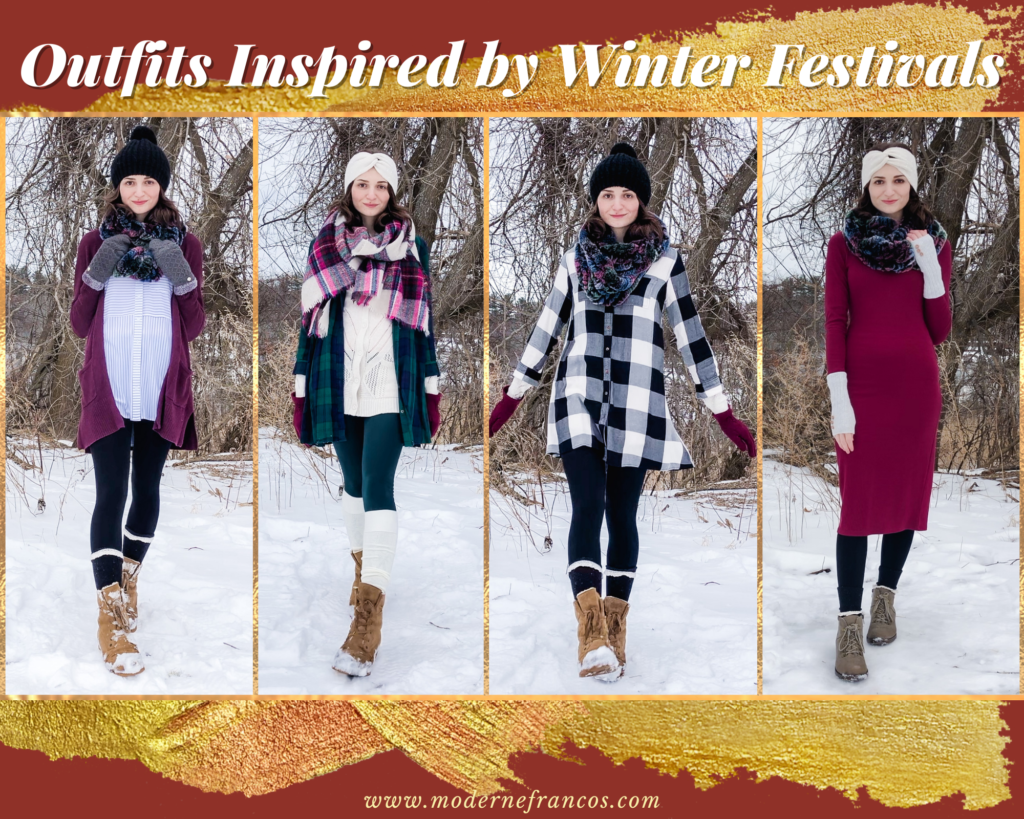
Starting from the first outfit on the left, I picked out the black leggings for warmth and functionality. These may not look like much, but they’re thicker than they look because they’re lined with fleece underneath. I prefer to wear longer tops with leggings, so this white collared top with thin, black stripes was the following selection. The stripes caught my eye as one of the most common patterns of the Winter Festival costumes. So, I paired it with a plum cardigan to add a pop of color and more warmth.
From there, I chose a fur scarf for function and matched the purple bits in the scarf with the cardigan. Personally, I don’t believe in buying furs, but this was gifted to me a few years ago. In my opinion, it’s nearly impossible to find alternatives for every piece in your wardrobe and it’s better to wear gifted or recycled animal products like fur and leather rather than let them waste away.
To make the plum cardigan the primary bold color of this ensemble, I went with my black pom-pom winter hat, gray mittens, and black socks with a feminine touch of a knitted lace design at the top. And every Winter Festival outfit needs snow boots, so I had to go with my only (but reliable) pair.
The plaid reveals itself in the second outfit! I knew I wanted to utilize my few pieces of this pattern because of its prevalence in Winter Festival photos (as well as being a staple of New England and Canada). After picking this green and blue plaid dress (although it fits like a long top on me), I paired it with emerald green fleece-lined leggings to match. Following the three-color formula, I focused on green being the primary color so I paired it with my plaid scarf with a mix of green, red, and pink. Because some of the reds in the scarf are darker and cool-toned, my burgundy gloves were a perfect match.
I added neutrals to the rest of the outfit to make the colors pop and not overdo it with more colors. So I chose a beige cardigan that happens to have a minimal design knitted into it. And lucky me, it’s neutral, so the pattern doesn’t distract from the two different plaids. Then, for the finishing touches, I picked out a pair of long, thick white winter socks and a beige knitted headband to add that crucial warmth and match the cardigan.
As mentioned, I wanted to utilize the few plaid pieces I own, so I knew I wanted to make an outfit from this black-and-white dress (which I also wear as a long top). First, I filled in the basics with my black fleece-lined leggings, black winter hat, and black socks with the knitted lace design. Because I matched the black neutrals together, this is a chance to highlight one bold color. I rarely wear black as a neutral, but I love pairing it with red tones when I do. So my burgundy gloves were an obvious fit.
I would have worn my plaid scarf with red, pink, and green, but the lighter colors washed everything out. Instead, I paired this with my fur scarf because the bits of black fur underneath help enhance the dark neutrals in this outfit. The jewel-toned surface of the scarf adds an interesting texture with subtle colors.
For the last outfit, I wanted to go in a more refined direction and utilize this deep red, long-sleeved mock turtleneck sweater dress I bought myself for Christmas. So often, I have a challenging time finding dresses that are long enough for me, so when I saw the length of this dress, I knew the fit would be perfect. Even though it’s semi-fitted, there’s an extra layer sewn in underneath, so it’s a winter-ready dress!
Next, I chose a pair of hand warmers that I had previously upcycled from an old pair of long socks. Had it been colder outside, I would have fit a pair of gloves underneath, but the makeshift hand warmers were enough for that day. Because I didn’t want chunky mittens interfering with the long, visual lines of the dress, that’s another reason I favored the sleeker hand warmers.
Because nothing says elegance like fur (even faux fur!), I knew that this scarf was the one to exude that more refined look while taking inspiration from les voyageurs. The beige headband was selected due to its roots in 1920s fashion with the popular styles of headwraps worn by women. Up close, this beige headband has faux pearl details sewn on the front, so it has an old-timey glam about it.
Finishing off with the basics, I layered up with a pair of fleece-lined tights that hold up remarkably well in cold temperatures. I partially covered the tights with the same black socks to match the tights, as well as lengthen the appearance of my legs to balance out the longer length of the dress. This is why I folded the knitted lace design downwards to prevent the light-colored design from creating a distinct line that would visually cut the smooth black lines of the tights and socks in half.
Because this particular day was warmer, I could get away with shorter boots that work well when I’m not trudging through six inches of snow. Similarly, with the pairing of the hand warmers giving a smoother appearance, I wanted to pair this outfit with smaller boots for a polished look. The elegant features would have been diminished if I had chosen my large snow boots. Out of these outfits, this one is my personal favorite for a formal event at a Winter Festival that I’m completely envisioning.
I know I’m not the only one who creates wild scenarios in my mind just to imagine what outfit I would wear to such an event. But now, if I’m on my way to a Winter Festival celebrating our French-Canadian voyageurs and culture, I’ll have my pick.
The alluring features of les costumes du voyageurs at these festivals is the effortless look of wearing anything you have on hand without looking like you sloppily threw on “just anything.” It could almost feel unsophisticated due to the heavy winter wear and the need to dress out of necessity anyway.
But with the additional intention of matching colors and creating intriguing looks by mixing textures and patterns in one outfit, it brings out the beauty in that necessity of utilizing what you already have to stay warm all winter. The style of les costumes du voyageurs in today’s Winter Festivals are a nod to acknowledging the beauty of the limited color palette in the cold, harsh winter season while throwing it back to our cultural roots.
While we’re incorporating inspiration from these costumes into our winter wear, we can discover the appeal of bold colors standing out against the icy, neutral environment. As well as embracing the earlier darkness until the daylight fully returns in the spring.
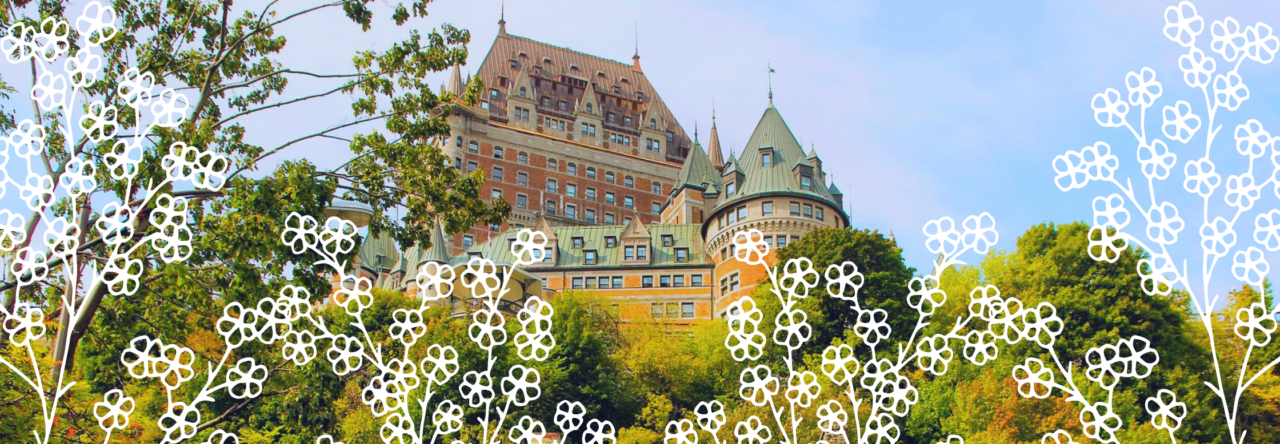
Rebecca Drew
What a fun article! You look absolutely lovely in your winter ensembles, too!
Luc Trepanier
Bravo pour cet article! Un travail est colossale!
Luc Trepanier
Un travail colossale!